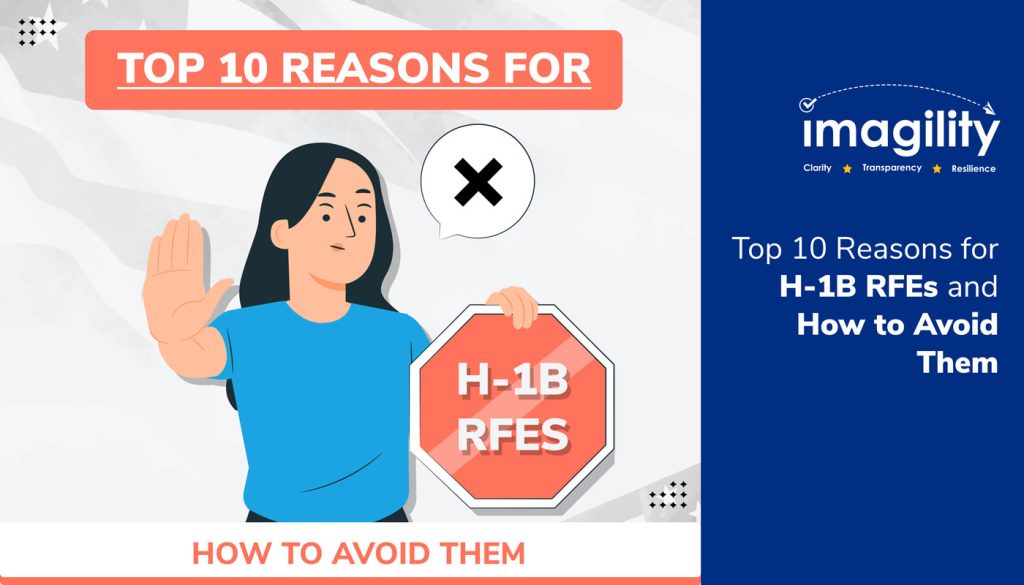H-1B RFE Reasons: Understanding Common Issues and How to Address Them
When applying for an H-1B visa, receiving a Request for Evidence (RFE) can be stressful. An RFE is a request from the U.S. Citizenship and Immigration Services (USCIS) asking for additional information to make a decision on your H-1B application. Understanding common RFE reasons can help you prepare and respond effectively.
- Specialty Occupation
RFE Reason
The petitioner failed to establish that the position qualifies as a specialty occupation under defined regulations.
How to Avoid
Clearly demonstrate that the position requires a bachelor’s degree or higher in a specific field. Provide the following.
- A detailed job description emphasizing specialized duties that require advanced knowledge.
- Evidence that similar roles in the industry require such qualifications.
- Relevant job postings, organizational charts, or industry documents showing that a degree is standard for the occupation.
- Employer-Employee Relationship
RFE Reason
Insufficient proof of a valid employer-employee relationship, particularly regarding the petitioner’s right to control the beneficiary’s work.
How to Avoid
Establish control by providing
- Contracts, offer letters, and agreements specifying the employer’s rights over the employee’s work.
- Clear statements showing how the employer will supervise, hire, fire, and manage the employee’s daily activities, even if the employee works off-site.
- Documentation of ongoing performance evaluations, timesheets, or communication between the employer and the employee.
- Availability of Work (Off-site)
RFE Reason
Lack of sufficient proof showing the petitioner has qualifying assignments for the beneficiary throughout the requested period.
How to Avoid
Provide clear documentation of the off-site project’s details, including
- Contracts or agreements with end clients.
- Detailed project descriptions, timelines, and dates.
- A well-defined work itinerary listing specific job duties and locations, along with letters from the end client confirming the work will last the entire period requested.
- Beneficiary Qualifications
RFE Reason
Inability to demonstrate that the beneficiary is qualified for the specialty occupation.
How to Avoid
Demonstrate the beneficiary’s qualifications by submitting:
- Degrees, diplomas, transcripts, and foreign credential evaluations (if applicable).
- Letters of experience from previous employers, demonstrating relevant work history.
- Certification or licensing (if the occupation requires it).
- Maintenance of Status
RFE Reason
The petitioner didn’t prove that the beneficiary properly maintained their current immigration status.
How to Avoid
Ensure all prior status documentation is up-to-date and properly maintained:
- Submit I-94 forms, visa stamps, and previous approval notices.
- Provide pay stubs, tax returns, or any evidence that shows the beneficiary maintained their nonimmigrant status.
- If there were gaps in employment or status, include an explanation letter with documentation of lawful reasons for the gap.
- Availability of Work (In-house)
RFE Reason
Lack of proof of specific, qualifying assignments in-house for the entire requested period.
How to AvoidProvide the following
- Evidence of in-house projects, including project timelines and roles the beneficiary will fulfill.
- Internal project details, including a list of deliverables and how the beneficiary will contribute.
- Organizational charts showing the beneficiary’s position and how they fit into ongoing work.
- LCA Corresponds to Petition
RFE Reason
Failure to show that the Labor Condition Application (LCA) corresponds to the proffered position and petition terms.
How to Avoid
Double-check that
- The LCA wage level, work location(s), and job duties match what is presented in the H-1B petition.
- Include any necessary amendments or additional LCAs if the employee will be working at multiple locations.
- Ensure the job title and wage offered on the petition match the details on the LCA.
- AC21 and Six-Year Limit
RFE Reason
Lack of evidence showing the beneficiary’s eligibility for AC21 benefits or an H-1B extension past the six-year limit.
How to Avoid
If applying for AC21 extensions
- Provide proof of an I-140 Immigrant Petition approval or pending PERM Labor Certification filed at least 365 days before the extension request.
- Submit evidence of time spent outside the U.S. to recapture time towards the six-year limit.
- Itinerary
RFE Reason
Failure to meet the itinerary requirement for services in multiple locations.
How to Avoid
Include
- A detailed itinerary listing each job location, with specific dates for each.
- Client letters or contracts for each worksite.
- A description of the tasks the beneficiary will perform at each location and how long each project will last.
- Fees
RFE Reason
Insufficient proof of payment for all necessary H-1B filing fees.
How to Avoid
Ensure that
- All fee payments are submitted, including checks or receipts as proof.
- If applicable, provide evidence of fee exemptions.
- Review USCIS’s filing fee guidelines and ensure correct payment for the petition category and processing times requested.
How to Respond to an H-1B RFE
When you receive an RFE from the USCIS, carefully review it to understand what additional information or clarification is needed. Gather the required evidence and provide the requested documents, and where applicable, offer additional evidence to support your case.
If you’re unsure how to respond, you can consider consulting with an immigration attorney or using a service like Imagility that can provide you with the support and expertise to address the RFE effectively. RFEs can be challenging, but understanding the common reasons and preparing a thorough response can increase your chances of a favorable outcome.
How Imagility Can Help
If you need assistance with H-1B RFEs, Imagility’s immigration management platform can help streamline your petition preparation process. From documentation to tracking deadlines, our technology ensures you avoid common pitfalls and stay ahead in the process. Get in touch with us today at +1 603 782 4622/+1 617 865 6588 for expert guidance!
Frequently Asked Questions on H-1B RFEs – FAQs
- What is an RFE (Request for Evidence) in the H-1B process?
An RFE is a request from USCIS for additional documentation or information to determine if an H-1B petition can be approved. It doesn’t mean the petition is denied but indicates that USCIS needs more proof to make a decision.
- Why did I receive an RFE for my H-1B petition?
RFEs are issued when USCIS requires more evidence on specific aspects of the petition, such as proving the position qualifies as a specialty occupation, showing an employer-employee relationship, or demonstrating the beneficiary’s qualifications.
- How long do I have to respond to an H-1B RFE?
USCIS typically gives a deadline ranging from 30 to 90 days to respond to an RFE. The exact timeframe will be mentioned in the RFE notice. It’s crucial to submit a complete response within the given time to avoid delays or denials.
- Can a Beneficiary Respond Directly to an RFE?
No, as the beneficiary, you cannot respond to an H-1B RFE directly. Just like with the H-1B petition, only the petitioning employer can submit the response. However, you can track the status of your case online using your receipt number to stay informed about any RFEs or updates.
Helpful Resources
RFE Response Builder Brochure
Navigating H-1B RFE Challenges: A Case Study with Imagility’s Response Builder
A Peek into RFE documents









